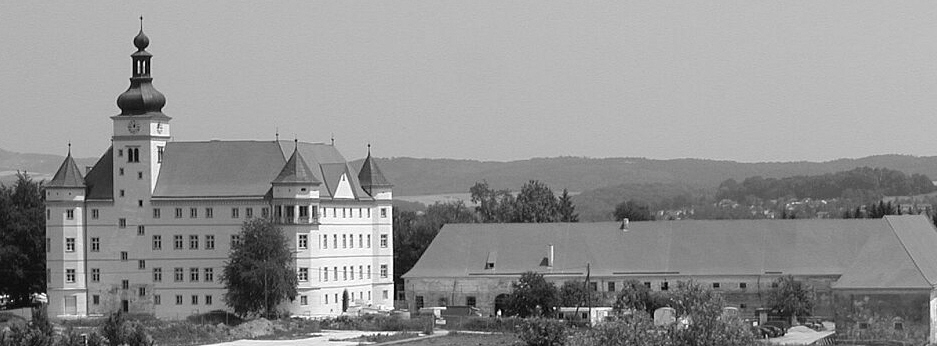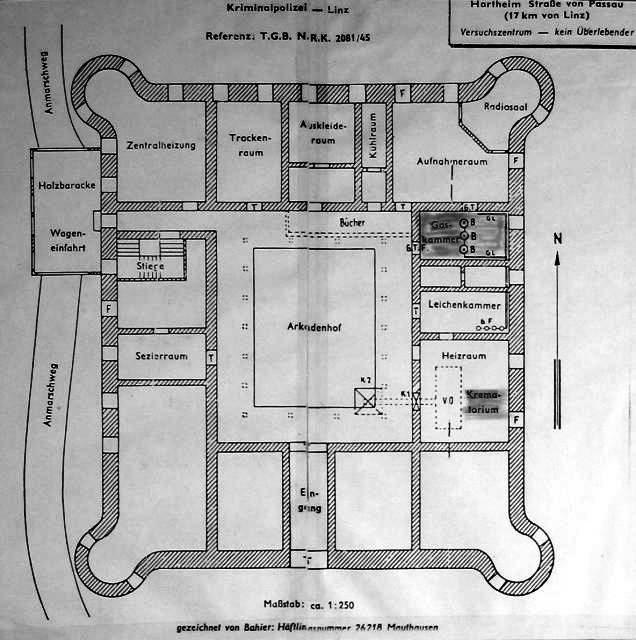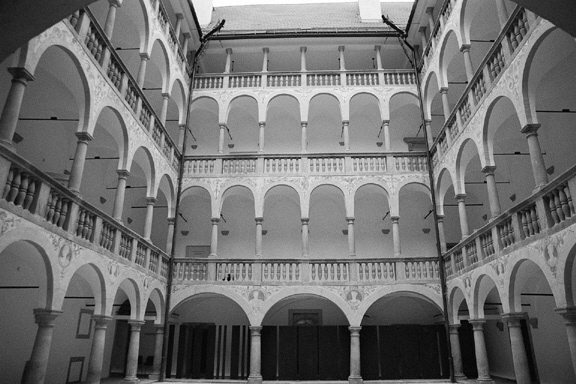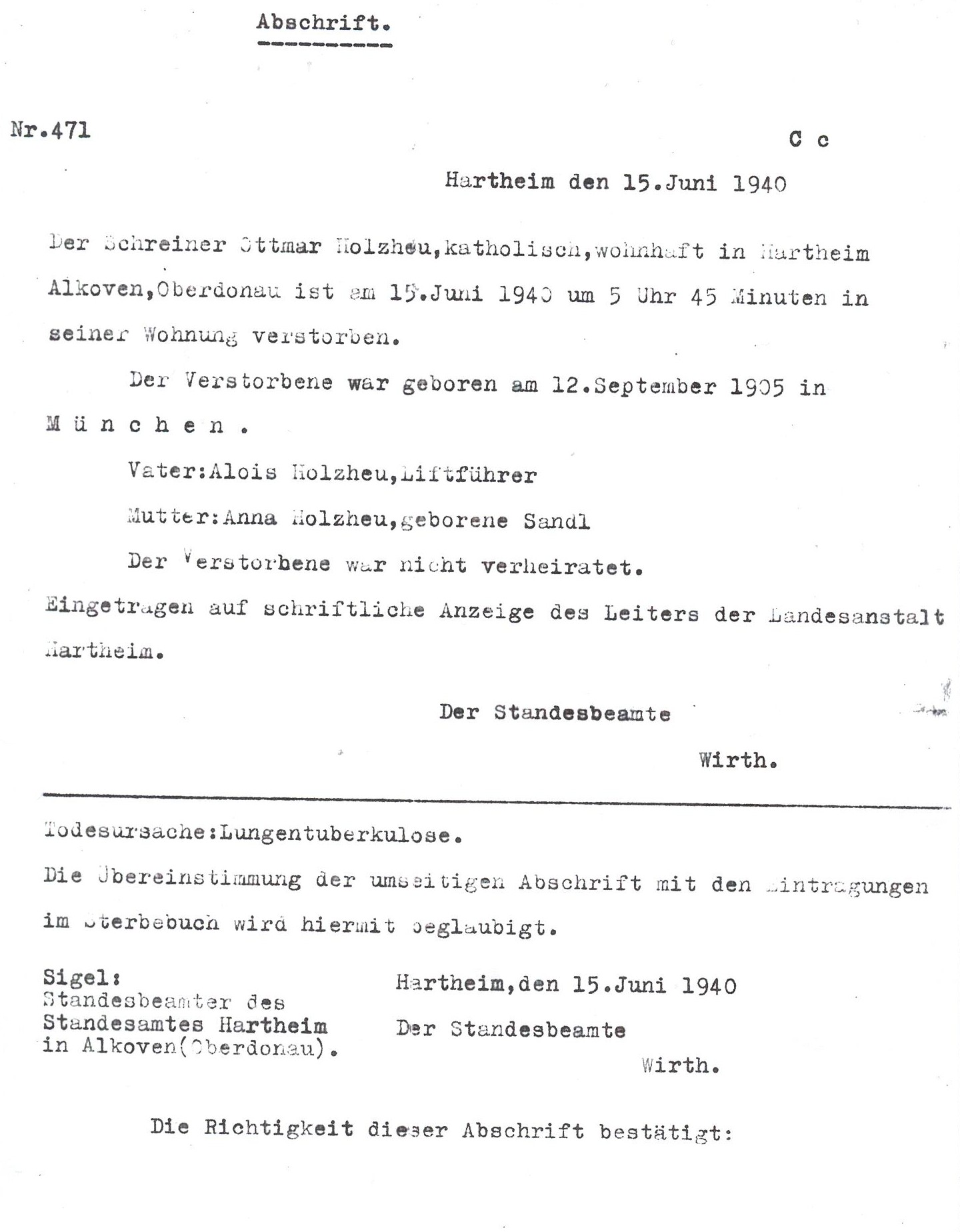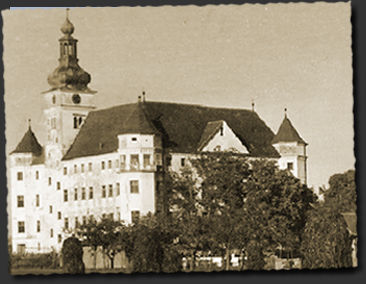Holocaust Education & Archive Research Team |
|
Euthanasia
Nazi Eugenics & Euthanasia T- 4 Staff T- 4 in Poland T - 4 in Germany & Austria | ||
Hartheim Euthanasia Center Hartheim castle, situated in the village of Alkoven near Linz in Austria, and close to the Mauthausen concentration camp, originally dated from the ninth century. The present castle was built at the end of the 16th century. By 1793 the building belonged to the princes of Starhemberg. In 1898 Hartheim castle was donated to the Landes wohltätigkeitsverein in Oberösterreich (Provincial Charity Club of Upper Austria), for the establishment of a home for physically and mentally handicapped children.
After the Anschluß, the building was confiscated, and between late 1939 and early 1940 the castle was converted into an Aktion T4 euthanasia centre with a gas chamber (5.8m long, 3.8m wide and 2.7m at its highest) and at least two crematoria, one located in a room on the east side of the interior courtyard and one in the courtyard itself. Offices and staff quarters were located on the upper floors of the castle, while the killing installation occupied the ground floor, which surrounded the inner courtyard. The gas chamber, also located on the east side of the courtyard, was disguised as a shower room and had a capacity of up to 150 persons. Senior stoker (Oberbrenner) Josef Vallasta often administered the gas and oversaw the gassing in place of a physician. At the western side of the castle a wooden annex was built for the reception of the victims, constructed so that their arrival remained unseen by others. During May 1940 the first 633 patients were gassed. Four drivers operated the large grey buses of the Gekrat organisation which carried the victims to the castle. After they had been gassed, any gold teeth were extracted from the corpses. If, following cremation, bones were still visible among the ashes, these were pulverized into dust with a bone mill. At least once a week a lorry left the castle and drove to the Rivers Donau and Traun to scatter the ashes on the water. The Austrian Vinzenz Nohel was assigned work as a stoker (brenner) at Hartheim, receiving wages of 170 Reichsmark (RM) per month, plus a 50 RM family separation allowance, a 35 RM stoker's allowance, and a 35 RM premium for keeping quiet. Further, "because the work [as a stoker] was very strenuous and nerve-shattering, we also received ¼ litre schnapps every day." Although it is impossible to calculate a definitive figure for the number of victims in respect of any of the euthanasia centres, it has been estimated that by August 1941 the death toll at Hartheim had risen to at least 18,269; later, during the Sonderbehandlung 14f13 operation, a minimum of 12,000 further victims were murdered., among them more than 8,000 inmates of the concentration camps Dachau and Mauthausen / Gusen .These included Russian prisoners-of-war, Hungarian Jews, Jehovah’s Witnesses and other Muselmänner. The first prisoners selected from Dachau (some of whom had voluntarily registered for transfer to a “convalescent camp” or “sanatorium”) arrived at Hartheim no later than January 1942. When the personal effects of transferees were returned to the camp with the address of the sender marked as “Hartheim”, the voluntary registrations ceased. Prisoners were also transferred to Hartheim from the Groß-Rosen, Sachsenhausen, and Ravensbrück concentration camps. They all shared a common fate. After late August 1941, when Hitler ordered a stop to the murder of the handicapped by gas, only concentration camp prisoners were gassed in T4 killing centres.
During the summer of 1943 Hartheim became an administrative department of Aktion T4, since Berlin was no longer considered safe. Another administrative department was installed at the Aktion T4 recreation facility "Haus Schoberstein" in Weissenbach, at the Attersee lake in Austria. The population in the vicinity of Hartheim castle had soon became aware of the killing. After the arrival of one of the grey buses, a dark cloud always appeared over the castle. On days when there was a low cloud base, smoke would spread over the town of Hartheim, smelling of burnt flesh and hair, and causing the townsfolk to be physically sick. The fact that many people were brought to the castle, but nobody left it, resulted in rumours being spread. To reassure the citizens, the Hartheim authorities arranged communal meetings. The townspeople were told that the vile odours had been caused by the use of contaminated oil. A warning was issued against persons speculating to the contrary. The last 14f13 gassing at Hartheim occurred on 11 December 1944. During December 1944 and January 1945 inmates of the Mauthausen concentration camp dismantled and removed the gassing installations. Although most of the T4 documentation was destroyed toward the end of the war, a U.S. War Crimes Investigating Team discovered a box in Hartheim containing statistical reports on the number of patients killed which have formed the basis of many subsequent attempts to establish the number of T4 victims. A number of Aktion Reinhard personnel served at Hartheim, including Heinrich Barbl, Kurt Bolender, Paul Bredow, Helmut Fischer, Kurt Franz , Anton Getzinger, Hans Girtzig, Hubert Gomerski, Karl Gringers, Ferdinand Grömer, Paul Groth, Gottlieb Hering, Fritz Hirche, Franz Hödl, Erwin Lambert, Hermann Michel, Wenzel Rehwald, Franz Reichleitner, Karl Richter, Paul Rost, Ernst Schemmel, Franz Stangl, Karl Steubl, Friedrich Tauscher, Josef Vallaster, Gustav Franz Wagner, Arthur Walther and Christian Wirth. The "Verein Schloss Hartheim" was founded in 1995 with the objective of perpetuating the history of the NS-euthanasia at Hartheim, and establishing an appropriate museum at the castle. In 2001, further significant traces of the euthanasia process were uncovered.
Sources Friedlander, Henry. The Origins of Nazi Genocide: From Euthanasia to the Final Solution, University of North Carolina Press, Chapel Hill, 1995. Kogon, Eugen; Langbein, Hermann; Rückerl, Adalbert; eds. Nazi Mass Murder, Yale University Press, New Haven and London, 1993 Lifton, Robert Jay. The Nazi Doctors – Medical Killing and the Psychology of Genocide, Papermac, London, 1990. http://www.schloss-hartheim.at
Copyright 2007 BB H.E.A.R.T
|
